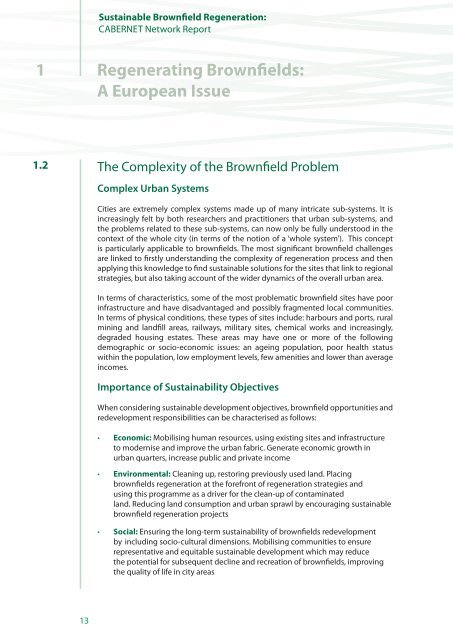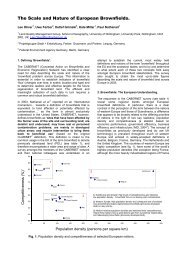Sustainable Brownfield Regeneration: CABERNET Network Report
Sustainable Brownfield Regeneration: CABERNET Network Report
Sustainable Brownfield Regeneration: CABERNET Network Report
You also want an ePaper? Increase the reach of your titles
YUMPU automatically turns print PDFs into web optimized ePapers that Google loves.
<strong>Sustainable</strong> <strong>Brownfield</strong> <strong>Regeneration</strong>:<br />
<strong>CABERNET</strong> <strong>Network</strong> <strong>Report</strong><br />
1<br />
Regenerating <strong>Brownfield</strong>s:<br />
A European Issue<br />
1.2<br />
The Complexity of the <strong>Brownfield</strong> Problem<br />
Complex Urban Systems<br />
Cities are extremely complex systems made up of many intricate sub-systems. It is<br />
increasingly felt by both researchers and practitioners that urban sub-systems, and<br />
the problems related to these sub-systems, can now only be fully understood in the<br />
context of the whole city (in terms of the notion of a ‘whole system’). This concept<br />
is particularly applicable to brownfields. The most significant brownfield challenges<br />
are linked to firstly understanding the complexity of regeneration process and then<br />
applying this knowledge to find sustainable solutions for the sites that link to regional<br />
strategies, but also taking account of the wider dynamics of the overall urban area.<br />
In terms of characteristics, some of the most problematic brownfield sites have poor<br />
infrastructure and have disadvantaged and possibly fragmented local communities.<br />
In terms of physical conditions, these types of sites include: harbours and ports, rural<br />
mining and landfill areas, railways, military sites, chemical works and increasingly,<br />
degraded housing estates. These areas may have one or more of the following<br />
demographic or socio-economic issues: an ageing population, poor health status<br />
within the population, low employment levels, few amenities and lower than average<br />
incomes.<br />
Importance of Sustainability Objectives<br />
When considering sustainable development objectives, brownfield opportunities and<br />
redevelopment responsibilities can be characterised as follows:<br />
• Economic: Mobilising human resources, using existing sites and infrastructure<br />
to modernise and improve the urban fabric. Generate economic growth in<br />
urban quarters, increase public and private income<br />
• Environmental: Cleaning up, restoring previously used land. Placing<br />
brownfields regeneration at the forefront of regeneration strategies and<br />
using this programme as a driver for the clean-up of contaminated<br />
land. Reducing land consumption and urban sprawl by encouraging sustainable<br />
brownfield regeneration projects<br />
• Social: Ensuring the long-term sustainability of brownfields redevelopment<br />
by including socio-cultural dimensions. Mobilising communities to ensure<br />
representative and equitable sustainable development which may reduce<br />
the potential for subsequent decline and recreation of brownfields, improving<br />
the quality of life in city areas<br />
13






